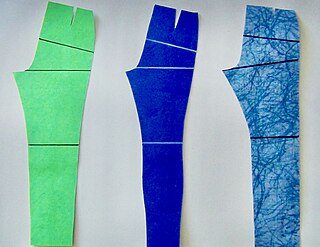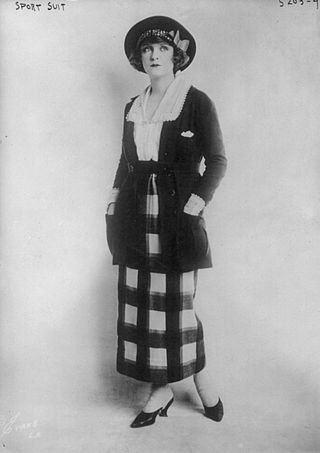Related Research Articles

William Ralph Blass was an American fashion designer. He was the recipient of many fashion awards, including seven Coty Awards and the Fashion Institute of Technology's Lifetime Achievement Award (1999).

Brioni is an Italian menswear luxury house based in Rome and specialised in sartorial ready-to-wear, leather goods, shoes, eyewear and fragrance, and provides a tailor-made service (Bespoke).

In sewing and fashion design, a pattern is the template from which the parts of a garment are traced onto woven or knitted fabrics before being cut out and assembled. Patterns are usually made of paper, and are sometimes made of sturdier materials like paperboard or cardboard if they need to be more robust to withstand repeated use. The process of making or cutting patterns is sometimes compounded to the one-word Patternmaking, but it can also be written pattern(-)making or pattern cutting.
Kim Niklas Jones is an English fashion designer. He is a graduate of Central St Martins College of Art and Design.

Buttonholes are reinforced holes in fabric that buttons pass through, allowing one piece of fabric to be secured to another. The raw edges of a buttonhole are usually finished with stitching. This may be done either by hand or by a sewing machine. Some forms of button, such as a frog, use a loop of cloth or rope instead of a buttonhole. Buttonholes can also refer to flowers worn in the lapel buttonhole of a coat or jacket, which are referred to simply as "buttonholes" or boutonnières.

History of fashion design refers specifically to the development of the purpose and intention behind garments, shoes an accessories, and their design and construction. The modern industry, based around firms or fashion houses run by individual designers, started in the 19th century with Charles Frederick Worth who, beginning in 1858, was the first designer to have his label sewn into the garments he created.

Richard Saturnino Owens is an American fashion designer from Porterville, California. In addition to his main line, Owens has a furniture line and a number of diffusion lines.
Junya Watanabe is a Japanese fashion designer, a protégé of Comme des Garçons designer Rei Kawakubo. He continues to work for Comme des Garcons: His atelier is located on the second floor of its Tokyo headquarters, and he produces four shows a year in Paris.

Fashion design is the art of applying design, aesthetics, clothing construction and natural beauty to clothing and its accessories. It is influenced by culture and different trends, and has varied over time and place. "A fashion designer creates clothing, including dresses, suits, pants, and skirts, and accessories like shoes and handbags, for consumers. He or she can specialize in clothing, accessory, or jewelry design, or may work in more than one of these areas."

Joseph Ephraim Casely-Hayford was a British fashion designer. Beginning in the mid-1980s he established an international reputation as one of the UK's most respected and consistently relevant designers of men's and womenswear clothing. He was appointed an Officer of the Order of the British Empire, for services to the fashion industry, in the 2007 Birthday Honours.

Sportswear is an American fashion term originally used to describe separates, but which since the 1930s has come to be applied to day and evening fashions of varying degrees of formality that demonstrate a specific relaxed approach to their design, while remaining appropriate for a wide range of social occasions. The term is not necessarily synonymous with activewear, clothing designed specifically for participants in sporting pursuits. Although sports clothing was available from European haute couture houses and "sporty" garments were increasingly worn as everyday or informal wear, the early American sportswear designers were associated with ready-to-wear manufacturers. While most fashions in America in the early 20th century were directly copied from, or influenced heavily by Paris, American sportswear became a home-grown exception to this rule, and could be described as the American Look. Sportswear was designed to be easy to look after, with accessible fastenings that enabled a modern emancipated woman to dress herself without a maid's assistance.

Comme des Garçons is a Japanese fashion label based in Paris that was created and led by Rei Kawakubo. Its French flagship store is located in Paris. This label owns a world-wide store chain featuring various lines of products in major cities such as London, Melbourne, Hong Kong, New York City and in the Ginza district of Tokyo. Other than fashion, the label has expanded to include jewelry and perfume.

Christopher Raeburn (born 13 August 1982) is a British fashion designer, known for reworking surplus fabrics and garments to create menswear, womenswear and accessories.
Zoran Ladicorbic, known as Zoran, is an American fashion designer who launched his business in 1976. He is particularly known for extremely minimalist, understated garments following the American sportswear principle, in neutral colors and high quality natural fabrics such as silk, linen and cashmere wool. His clothes have been described as "Gap for the very rich", and as "revolutionary" due to being designed without "built-in obsolescence".
Maison Margiela, formerly Maison Martin Margiela, is a French luxury fashion house founded by Belgian designer Martin Margiela and Jenny Meirens in 1988 and headquartered in Paris. The house produces both haute couture-inspired artisanal collections and ready-to-wear collections, with the former influencing the designs of the latter. Product lines include womenswear, menswear, fine jewelry, footwear, objects, fragrance, and home goods, among others. Known for deconstructive and avant-garde designs with unconventional materials, Maison Margiela has traditionally held live shows in unusual settings, for example empty metro stations and street corners. Models' faces are often obscured by fabric or long hair to direct attention to the clothes and design. Margiela resigned as creative designer in 2009 and John Galliano was appointed to the role in 2014.
mono.kultur is a quarterly magazine publishing interviews with creatives in the arts and culture in a wider sense.

John Flett was a British fashion designer who achieved early success with his own brand before designing briefly for Claude Montana. He died of a heart attack at the age of 27, while working in Florence.

Aitor Throup is an artist, designer and creative director.
Sonja Jocić is a Serbian fashion designer known for her origami shapes, draped layering, and androgynous silhouettes, as well as for creating sustainable fashion. Her work is described as having a Scandinavian minimalism that contrasts black and white tones, also playing "... at the border of clothing and sculpture."
Paul Surridge is a British fashion designer and art director.
References
- ↑ Davis,Hywel (2008).Modern Menswear.Lawrence King Publishing Ltd.
- ↑ Bücker,Silke (2007).Interview for the Goethe-Institute.Goethe-Institute
- ↑ von Rabenau,Kai (2005).Mono.Kultur#02 Frank Leder: Fabrics for Thought.Mono.Kultur
- ↑ Davis,Hywel (2008).Modern Menswear.Lawrence King Publishing Ltd.
- ↑ Barth,Nadine (2008).Berlin Fashion.DuMont Buchverlag
- ↑ von Rabenau,Kai (2005).Mono.Kultur#02 Frank Leder: Fabrics for Thought.Mono.Kultur
- ↑ von Rabenau,Kai (2005).Mono.Kultur#02 Frank Leder: Fabrics for Thought.Mono.Kultur
- ↑ Marx,Ilona (2006).Umlaut Mode_01.Tisch7 Verlagsgesellschaft